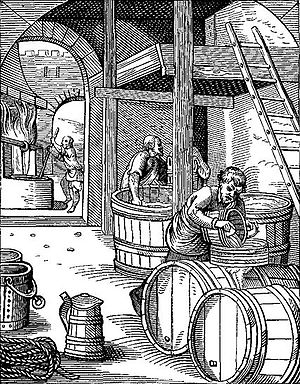I formulated this recipe to produce five gallons of beer for packaging. I assume a boil-off rate of 0.9 gallons per hour with a full-volume boil. I use bagged pellet hops for all hop additions. I assume a loss due to trub of a half-gallon in the boil kettle and another half-gallon in the fermenter.
Recipe: Brush Valley Brewing House Ale v1.4
BJCP Style: 14B — American IPA
Brewhouse Efficiency: 77%
Pre-Boil Volume: 7 gallons (26.5 L)
BG: 1.052 SG (12.7 °P)
Original Volume: 6.1 gallons (23.1 L)
OG: 1.059 SG (14.5 °P)
FG: 1.016 SG (4.1 °P)
ADF: 73%
Bitterness (Tinseth): 59 IBU
ABV: 5.9%
Color (Morey): 11 SRM (21 EBC) — Deep amber
Boil Duration: 60 minutes
BU:GU 0.99
Balance value: 1.98
Calories per 12-ounce Serving: 200 — 116 from Alcohol, 85 from Carbs
| Grains | Quantity | Percent |
|---|---|---|
| Crisp Maris Otter Malt (3.5 °L) | 11.0 lb. (4.990 kg) | 88 |
| Crisp Light Crystal Malt (45 °L) | 1.5 lb. (0.680 kg) | 12 |
| Hops | ||
| Chinook, 10.9% AA, 60 min, 1.73 oz (49 g) | 48.6 IBU | 82 |
| Chinook, 10.9% AA, 10 min, 0.63 oz (18 g) | 6.5 IBU | 11 |
| Chinook, 10.9% AA, 5 min, 0.63 oz (18 g) | 3.6 IBU | 6 |
| Chinook, 10.9% AA, dry, 2.0 oz (57 g) | 0 IBU | 0.33 oz/gal |
| Other Ingredients | ||
| Brewer’s Choice™ Wyeast Nutrient Blend | ||
| Irish Moss | ||
| Yeast | ||
| Wyeast 1768-PC English Special Bitter Yeast | 227B Cells | |
| Water Treatment | Mash | Boil |
| Gypsum (CaSO₄) | 2.0 g | 1.5 g |
| Calcium Chloride (CaCl₂) | 2.0 g | 1.5 g |
Adjusted Mash Water Profile
| Calcium (Ca): | 107 ppm |
| Magnesium (Mg): | 3 ppm |
| Sodium (Na): | 1 ppm |
| Bicarbonate (HCO₃): | 143.4 ppm |
| Carbonate (CO₃): | 0.3 ppm |
| Sulfate (SO₄): | 71 ppm |
| Chloride (Cl): | 57 ppm |
| Total Alkalinity (CaCO₃): | 119 ppm |
| Residual alkalinity: | 41 |
| pH: | 7.6 |
Step by Step
This is a single step infusion mash at 1.54 quarts/pound with a batch sparge. It will require a total of 8.5 gallons (32.2 L) of water.
Heat 5 gallons (18.9 L) of strike water in the Hot Liquor Tank to 178 °F (81 °C). Drain the strike water into the mash tun. Mix in the crushed grain and the mash salts, making sure to break up any dough balls. Cover the mash tun and let it sit for about 10 minutes. The mash should stabilize at 156 °F (69 °C). Cover the mash tun and let it rest.
After 60 minutes vorlauf and lauter. Sparge with 3.5 gallons (13.2 L) of water to bring the collected volume to approximately 7 gallons (26.5 L) at 1.052 SG (12.7 °P).
Add the boil salts and boil for 60 minutes. While boiling, add the remaining ingredients according to the schedule in the ingredient list.
After the boil, cool the wort to 66 °F (18.9 °C). The volume should be approximately 6.1 gallons (23.1 L) at 1.059 SG (14.5 °P). Transfer approximately 5.5 gallons (20.8 L) to a sanitized fermenter. Aerate the wort and pitch the yeast.
Hold at 66 °F (18.9 °C) until fermentation is complete. The final gravity should be about 1.016 SG (4.1 °P).
When fermentation is complete, let the beer stand at room temperature for 24 hours. After 24 hours, add dry hops for five days. After five days, cold crash the beer to 38 °F. After three days, keg the beer. Store at 48 °F and force carbonate to 2.2 volumes of CO2.
The beer should be at its peak in 12 to 19 days.


